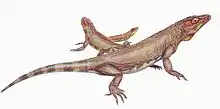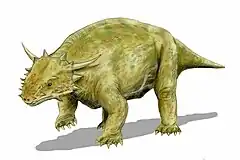Embrithosaurus
Embrithosaurus was a pareiasaur from the Permian of South Africa.[1]
| Embrithosaurus Temporal range: | |
|---|---|
| Scientific classification | |
| Kingdom: | |
| Phylum: | |
| Class: | |
| Order: | |
| Family: | |
| Genus: | †Embrithosaurus Watson, 1914 |
| Type species | |
| †Embrithosaurus schwarzi Watson, 1914 | |
| Species | |
| |
| Synonyms | |
| |
Description
Embrithosaurus was 3 metres (9 ft 10 in) in length[2] and 600 kilograms (1,300 lb) in weight. The skull is relatively deep and narrow. The body is lightly armoured with thin, smooth dermal scutes.
Species
- E. schwarzi (Watson, 1914). The type species. This is the most advanced species of this genus, as indicated by the teeth, which have nine cusps (in three groups of three). In cladistic analyses it is used as the monotypal species for the genus.
- E. alexanderi (Haughton and Boonstra, 1929). This species was made the type for "Dolichopareia". As the name indicates, the skull is long and narrow. This would seem to indicate a different lifestyle or diet to other parieasaurs. More recently, it has been used as the monotypal species for the genus Nochelesaurus[3] (it is not clear what the status of Embrithosaurus strubeni is, this may be a further transitional species). In cladistic analyses, this species is phylogenetically intermediate between Bradysaurus seeleyi and Embrithosaurus schwarzi.
- E. strubeni (Broom, 1924). The skull is large and deep, pointed at the front, and elevated in the jugal region. This species was originally made the type species of Nochelosaurus by Haughton and Boonstra. Boonstra later (1969) moved it into the genus Bradysaurus, on the basis of the primitive tooth structure. Kuhn however considers it belongs under Embrithosaurus.
References
- Google Books
- Marco Romano, Fabio Manucci, Bruce Rubidge, Marc J. Van den Brandt (17 June 2021). "Volumetric Body Mass Estimate and in vivo Reconstruction of the Russian Pareiasaur Scutosaurus karpinskii". Frontiers in Ecology and Evolution. 9. doi:10.3389/fevo.2021.692035.
{{cite journal}}: CS1 maint: multiple names: authors list (link) - Van Den Brandt, Marc J.; Rubidge, Bruce S.; Benoit, Julien; Abdala, Fernando (March 2021). "Cranial morphology of the middle Permian pareiasaur Nochelesaurus alexanderi from the Karoo Basin of South Africa". Earth and Environmental Science Transactions of the Royal Society of Edinburgh. 112 (1): 29–49. doi:10.1017/S1755691021000049. ISSN 1755-6910. S2CID 233839915.
This article is issued from Wikipedia. The text is licensed under Creative Commons - Attribution - Sharealike. Additional terms may apply for the media files.






